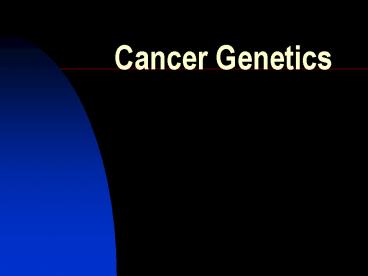Cancer Genetics - PowerPoint PPT Presentation
1 / 26
Title:
Cancer Genetics
Description:
Breast, skin, colon. Sarcoma-connective tissue cancer. Ie. Muscle, bone ... Colon cancer 'runs in families' BRCA1, BRCA2 genes in breast cancer ... – PowerPoint PPT presentation
Number of Views:2258
Avg rating:5.0/5.0
Title: Cancer Genetics
1
Cancer Genetics
2
Introduction
- Cancer uncontrolled proliferation of cells
somewhere in the body - Loss of control of the cell cycle
- Cancer is genetic, but not inherited
3
Definitions
- Tumor (aka-neoplasm)-growing mass of abnormal
cells - Benign-single clustered mass of neoplastic cells
- Malignant-cells invade surrounding tissue
- Metastasis-spread of cancer cells/formation of
secondary tumors at other sites
4
Types of Cancers
- Carcinoma-epithelial tissue cancer
- Ie. Breast, skin, colon
- Sarcoma-connective tissue cancer
- Ie. Muscle, bone
- Leukemia-cancer of blood forming tissues
- Glioma, neuroblastoma-nervous tissue cancer
5
Cells Dont All Divide at the Same Rate
- No cell division-neurons, skeletal muscle cells
- Slow cell division-liver cells divide once or
twice a year - Rapid cell division-gut epithelial cells divide
more than twice per day
6
Cells Division Rate Varies With External
Environment
- Blood loss-proliferation of blood cell precursors
(aka blood stem cells) - Acute liver damage-liver cells can regenerate
- Wounds-cells in neighborhood of wound are
stimulated to divide to repair lesion
7
Contact Inhibition
- Aka- density dependent inhibition
- Normally, when cells are touched on all sides by
other cells, they stop dividing - Cancer cells dont obey the rules
- Begin to invade tissue because they divide faster
than other cells
8
Figure 12.16 Density-dependent inhibition of
cell division
9
How Cancer Begins
- Scientists have noticed for centuries the
correlation between - carcinogenesis-generation of cancer
- and mutagenesis-change in DNA sequence
10
Carcinogens
- Chemicals that induce cancer
- Act directly or are activated metabolically
- I.e. Tobacco smoke
11
Mutagens
- Substances that induce mutations in DNA
- I.e., ionizing radiation, x-rays
- Not all mutagens are carcinogens
12
Molecular Genetics of Cancer
- Cancer is disruption of cell growth controls
- Cells remain in G1 until chemicals signal them to
go to the next stage - depends on
- growth factors from outside the cell (first
messengers) - transcription factors from within
13
Proto-oncogenes
- products of these genes stimulate an increase in
cell number - Are growth stimulators
- I.e. a GO signal
- or a cars accelerator
- Mutation causes gene to become an oncogene, or
tumor gene - Result is an inappropriate rate of mitosis, too
fast - accelerator stuck
14
Proto-oncogenes
- active where and when a high rate of cell
division is necessary - I.e. Wound healing, growing embryos
- When mutated, products are over-expressed
- Become oncogenes, or cancer-causing genes
15
Figure 19.13 Genetic changes that can turn
proto-ocogenes into oncogenes
16
Tumor Suppressor Genes
- Genes whose products inhibit cell growth
- I.e. STOP signal
- Or like a cars brake
- Some commit the cell to apoptosis
- Mutation of these genes causes less cell death
17
p53-a tumor suppressor
- first described as protein of 53,000 MW
- Codes for a transcription factor, or a genes on
switch - Gene products job is to delay the cell cycle at
G1 - Allows cell to repair DNA damage, stop dividing,
or undergo apoptosis - No delay-cell divides despite DNA
damage-replicates these mistakes - About 50 of cancers involve p53 mutations
18
How Does a Cell Decide to Divide?
- Cell signal transduction
- 1st messenger signals cell
- 2nd messenger relays message to nucleus in a
series of step - Like a bucket brigade
- Current model has 10 steps
- Each step is controlled by a gene
19
Cancer not caused by a single mutation
- Cancer rate increases with age-why?
- The longer you are alive, the more you have
exposed to mutagens - Current model-cells require between 4-9 mutations
in the cell signaling pathway of the SAME cell to
become a cancer cell - Progressive loss of control of cell cycle in that
cell - Mitosis rate in that cell increases
- Its descendents increase faster than cells around
it
20
Figure 19.14 Signaling pathways that regulate
cell growth (Layer 1)
21
Figure 19.14 Signaling pathways that regulate
cell growth (Layer 2)
22
Figure 19.14 Signaling pathways that regulate
cell growth (Layer 3)
23
The picture becomes more clear.
- The steps are products of proto-oncogenes and
tumor suppressor genes - Ie. normal cell growth regulators
- Cancer is the result of damage to the DNA in the
genes that control the cell cycle - Therefore, all cancer is genetic
24
Some cancers run in families
- Recall that in order for changes in genes to be
inherited, they must occur in the germ line - These are usually somatic cell mutations which
arent inherited - If in the germ line, however, single mutations
can be inherited - Ie. would be born with a predisposition to
cancer - Inherit one or two already mutated cell cycle
genes - Colon cancer runs in families
- BRCA1, BRCA2 genes in breast cancer
25
Figure 19.15 A multi-step model for the
development of colorectal cancer
26
Cancer and age
- The above mutations would happen over time and
accumulate - Perhaps individual above was born with already
mutated APC gene - Forms polyps more readily than general population
- Other random mutations happen over time in cells
of polyp - Cancer eventually develops
- Can try to control exposure to mutagens































